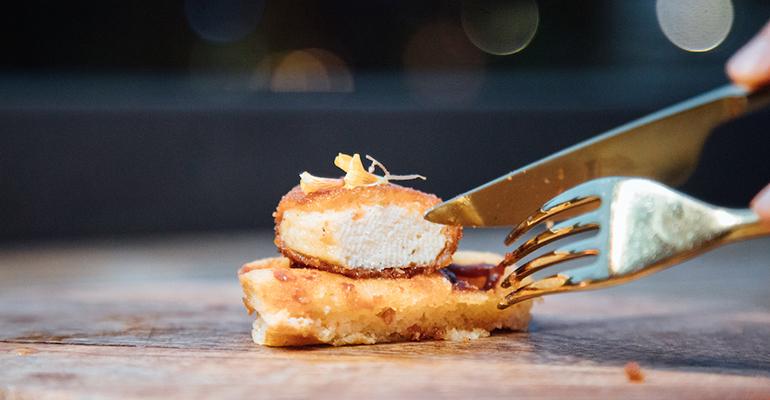Senior food and beverage editor Bret Thorn and food trend expert Nancy Kruse discuss the latest cultural trends in this column.
Bret Thorn begins:
Well Nancy, lab-grown meat is now available for public consumption, at least in Singapore.
In December the city-state known for, among other things, its great street food, its humorless one-party government, and being the setting for the hit film Crazy Rich Asians gave the nod for Eat Just Inc. to sell its manufactured chicken in restaurants.
Eat Just, known for its egg-free Just Mayo and Just Egg, has now come up with “cultured chicken” for which no animals were harmed.
 I haven’t received precise details for how Eat Just manufactures its chicken, but as you’ll recall from our past discussions of this type of food, descriptions of production of similar animal-free meat go like this: Cells are extracted from an animal and then treated with nutrients until they divide, and then they’re placed in a bioreactor similar to a fermenting tank to grow and grow and become something more-or-less equivalent to meat.
I haven’t received precise details for how Eat Just manufactures its chicken, but as you’ll recall from our past discussions of this type of food, descriptions of production of similar animal-free meat go like this: Cells are extracted from an animal and then treated with nutrients until they divide, and then they’re placed in a bioreactor similar to a fermenting tank to grow and grow and become something more-or-less equivalent to meat.
BlueNalu, a manufacturer of lab-grown yellowtail based in San Diego, pointed me to a story in the San Diego Union Tribune that describes their process in more detail:
• Muscle tissue is taken from an anesthetized fish.
• Stem cells from that tissue are isolated and treated with enzymes.
• Those stem cells are placed in a bioreactor in a nutrient-rich solution that encourages them to multiply while an agitator keeps them from clumping.
• The cells are placed in a centrifuge that separates them from excess materials
• The cells are mixed with “a nutritious liquid called bio-ink” and are then formed into the desired shape by a 3-D printer.
That last step — the 3-D printing — is new to me, and BlueNalu’s process is, according to the Union Tribune story, an advance over competitors such as San Francisco-based salmon manufacturer Wild Type because it can be eaten raw, acidified (à la ceviche) or cooked; apparently Wild Type’s product falls apart when cooked at high temperature.
In the past, Nancy, you’ve said that lab-grown — or “cultured,” or “cell-based” as its various manufacturers seem to prefer — meat flies in the face of trending consumer values toward natural, wholesome, clean labeled food.
Jack Li, founder and self-proclaimed “haiku master” of menu research firm Datassential, begs to differ. He says that among young consumers, particularly those in Generation Z, born after around 1995, trying new things because they’re new is an important part of their identity, which they must broadcast constantly on their social medium of choice.
He said that to the four major drivers of food choice — taste, convenience, affordability and familiarity — must now be added a fifth driver: personal values. That means that the same people who gravitate toward natural, organic and GMO-free items could also be drawn to the lab, where food is made without harming animals and with minimal environmental impact.
Eat Just points out that only the parts of the chicken that we eat are manufactured — no beaks or bones — making for more efficiency and a process that it says takes only weeks, rather than months or years.
Guests at 1880 in Singapore sampled Eat Just's new cultured chicken in a room with wall-to-wall video screens.
As you probably know, Nancy, it only takes around five or six weeks to grow a chicken from egg to slaughterhouse using conventional means, but let’s let that go for now, because I see the appeal of meat made without harming animals in a way that’s gentler on the environment and that actually does act like meat in the kitchen and taste and feel like meat in my mouth, which maybe this cultured meat does.
To get buy-in from the Influencer crowd in Singapore, Eat Just introduced its new cultured, breaded Chicken Bites at 1880, a club with the goal of fostering world-changing conversations — lofty, sure, but a good idea.
They started serving the chicken bites at sold-out dinners in a high-concept room with videos of cosmic and natural settings broadcast on the four walls. Very Instagrammable, or TikTok-friendly, or whatever.
I’ll close, Nancy, with a summary of a conversation I had with a ride-share driver in Denver in 2019.
He asked my job, and I told him, and he asked if I’d written about lab-grown meat, and I said that I had. He asked if I thought maybe we’d grow human flesh, you know, just to try it. And then he wondered if maybe there’d be a movement, like there is among some people who advocate only drinking mother’s milk (rather than that of cows or sheep or goats), because it’s more natural for us, to eat only cultured human flesh.
That’s my way of saying that cultured meat opens a whole vista of culinary and philosophical possibilities to explore, and I’m eager to hear your take.
Nancy Kruse responds:
You paint a very vivid picture, Bret, of the genesis of lab-grown meats. In fact, your riveting description of bioreactors, fermentation tanks, agitators, centrifuges, bio-inks, 3-D printing, culturing organisms and stem cells conjures a classic movie scene. It’s the one in which Victor Frankenstein, successful at last in harnessing the power of lightning to ignite life, stands in front of his twitching creature on the table and cackles wildly, “It’s alive, it’s alive!”
A little melodramatic, perhaps, but an appropriate analogy, I think, given that food activists coined the term Frankenfoods to describe the genetically modified products they disparage. How they’ll respond to these lab-grown inventions is merely one obstacle the producers will face in their bid to gain acceptance.
Another will be the need to demonstrate total transparency regarding additives, preservatives and artificial colors. Bio-ink? It sounds a little like heme, the ingredient that gives the Impossible Foods burger its distinctive, beef-like “bleed” and is currently subject of a lawsuit (turns out the substance genetically modified from soybeans and yeast). And these manufacturers will also have to muster strong arguments around nutrition, since they propose to replace meats and seafoods that consumers consistently rate very highly on the basis of proteins and myriad other nutrients.
Then there’s the concept of personal values. There’s no question that these are powerful drivers of buying behavior, but that’s always been the case. Environmental concerns currently animate many consumer choices, as do touchy-feely appeals like “authentic,” “real,” “natural” and “holistic.” I question how cell-based meats will measure up to these last, especially with Millennial and Gen Z influencers and mommy bloggers. The bottom line for the latter group will be whether or not they’ll feed this stuff to their kids, which is almost surely a nonstarter.
 From the restaurant operator perspective, there will be predictable challenges around food cost and menu pricing, not to mention taste, texture and handling in the back of house, all of which, along with charges of hyper-processing and additive use, have dogged the adaptation of plant-based meat alternatives. A common approach to overcome any shortcomings of palatability is to disguise them, often with produce and condiments, as with Burger King’s Impossible Whopper, or with sauces and cheese, as with Corner Bakery’s Beyond Meatball Linguine.
From the restaurant operator perspective, there will be predictable challenges around food cost and menu pricing, not to mention taste, texture and handling in the back of house, all of which, along with charges of hyper-processing and additive use, have dogged the adaptation of plant-based meat alternatives. A common approach to overcome any shortcomings of palatability is to disguise them, often with produce and condiments, as with Burger King’s Impossible Whopper, or with sauces and cheese, as with Corner Bakery’s Beyond Meatball Linguine.
Which brings us to where the rubber will really meet the road: the center of the plate. According to the Washington Post, that’s exactly the target of an Israeli-based company called Aleph Farms, which is “raising the steaks” with a ribeye that is 3-D bio-printed to yield a premium, whole-muscle cut with the marbling of conventional steak.
Aleph Farms’ CEO says his goal is not to replace traditional agriculture, but rather to build a second category of meat, one in which his farmers — er, sorry, scientists — can control for variations in collagen, connective tissue and other differences among various breeds of cattle and what they’re fed. These components can be manipulated to suit the differing tastes of a specific population. The products will be free from antibiotics and shipped with certified zero pathogens to enhance shelf life. While there’s no report on when exactly our regulatory agencies will weigh in on knotty issues relating to labeling, a pitched and protracted battle is guaranteed to ensue.
In the meantime, operators have the opportunity to address some underlying patron apprehensions that have contributed to the creation of these meat wannabes, whether plant based or lab fabricated.
The first line of defense, I believe, is to continue the unbridled innovation in the vegetable category. Produce of all types has been sizzling hot on bills of fare and offers lots of upside relative to variety, versatility, cost and pricing, and patron acceptance. Vegetables address demand for real, authentic and natural foods while supporting lots of farmers. Combining culinary creativity with the halo of health and the opportunity to do good at the same time is the golden ticket.
The other area of innovation to watch is in meat and seafood production. Improved real meat may be the better bet for many carnivorous consumers. Yes, it will take some time to commercialize the amount of, say, environmentally kinder low-methane beef to the scale needed to meet demand, but cattlemen are on the case with these and other initiatives. And the lab-grown competition faces similar challenges of scale as they attempt to ramp up production and gin up demand.
What’s more, ranchers and fishermen have the competitive advantage of motivated, promotion-prone restaurant partners. Chick-fil-A has been out front with its “no antibiotics ever” chicken, McDonald’s has rolled out a very successful fresh beef Quarter Pounder, Burger King did a slyly smart Clean Label Whopper promotion as well as a limited test of low-methane beef last year, and other chains are touting their alliances with smaller, local suppliers like Capriotti’s Snake River Farms Wagyu beef sandwich.
Let’s cut to the chase here, Bret. You and I can opine until the cows, real, not lab grown, come home, but it is consumers who will ultimately decide whether or not there’s actually need for a second category of meat. It will be interesting to watch how they navigate their way through the oncoming deluge of information, disinformation and publicity.
Contact Bret Thorn at [email protected]
Follow him on Twitter: @foodwriterdiary
Nancy Kruse, president of the Kruse Company, is a menu trends analyst based in Atlanta and a regular contributor to Nation’s Restaurant News.
E-mail her at [email protected]





